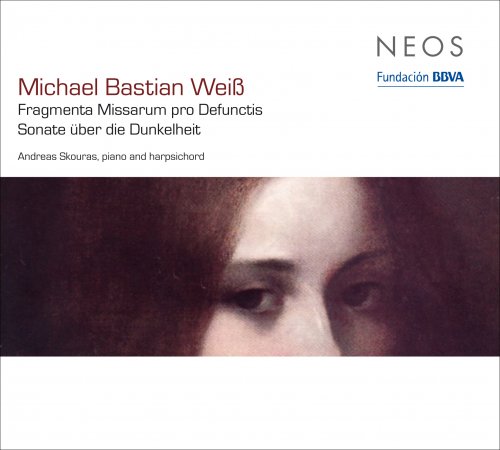
Andreas Skouras - Weiß: Fragmenta Missarum pro Defunctis, Sonate über die Dunkelheit (2009)
BAND/ARTIST: Andreas Skouras
- Title: Weiß: Fragmenta Missarum pro Defunctis, Sonate über die Dunkelheit
- Year Of Release: 2009
- Label: Neos
- Genre: Classical
- Quality: FLAC (tracks)
- Total Time: 01:15:16
- Total Size: 315 Mb
- WebSite: Album Preview
Tracklist:
Fragmenta Missarum pro Defunctis, Op. 7 (Michael Bastian Weiss)
01. I. Luceat eis - 00:13:27
02. II. Per sepulcra - 00:11:20
Sonate uber die Dunkelheit (Sonata on Obscurity), Op. 13, 'Symphony No. 2' (Michael Bastian Weiss)
03. A. Einleitung, "Mignon" - 00:09:54
04. B. Die Arie der Maschine - 00:08:42
05. C. Scherzo - 00:08:56
06. D. Passacaglias - 00:05:00
07. E. Finale: Adagio molto - 00:17:57
Performers:
Andreas Skouras (piano & harpsichord)
Fragmenta Missarum pro Defunctis, Op. 7 (Michael Bastian Weiss)
01. I. Luceat eis - 00:13:27
02. II. Per sepulcra - 00:11:20
Sonate uber die Dunkelheit (Sonata on Obscurity), Op. 13, 'Symphony No. 2' (Michael Bastian Weiss)
03. A. Einleitung, "Mignon" - 00:09:54
04. B. Die Arie der Maschine - 00:08:42
05. C. Scherzo - 00:08:56
06. D. Passacaglias - 00:05:00
07. E. Finale: Adagio molto - 00:17:57
Performers:
Andreas Skouras (piano & harpsichord)
Bavarian-born composer Michael Bastian Weiß has studied both music and philosophy, and his notes to the two-movement Fragmenta Missarum pro Defunctis (Fragments of a Mass for the Dead) -- although not, curiously, for the other work on the disc, the Sonate über die Dunkelheit (Simphonie Nr. 2) -- have a philosophical orientation. The Fragmenta Missarum, he said, apply "a topos of recent musical history, namely working with stillness," to the problem of "reacting to a historical disaster that caused considerable pain to countless people." The work was composed in 2000, and this presumably refers to the Holocaust. Listeners will have to decide for themselves whether the music makes the connection; it begins, as the composer's words suggest, with almost complete silence broken only occasionally by quiet, single-piano chords. The music returns to this stillness, slightly altered in a brighter direction. Weiß names Webern as an influence, and indeed the music suggests something that the young, pre-twelve-tone Webern might have hit on if he had devised his minimal textures further in advance of the twelve-tone system. Perhaps more successful is the five-movement Sonate über die Dunkelheit (Sonata on Darkness), which despite its name has periods of light and shade. The work is written for a two-manual harpsichord on which one manual is tuned a quarter-tone lower than the other. The work explores various ideas, one of which is the shimmering beats that occur when the two manuals sound together; the massive 18-minute finale ties all the strands together. "I forgo the radicality of Cage or Feldman," Weiß wrote about the Fragmenta Missarum, and the statement could apply to the sonata, as well; there are temporary tonal fields and a sort of ornamental use of little melodies. This is certainly music for listeners with patience, but the processes Weiß uses are clear, and his mode of expression is consistent. The extensive documentation is given in English, French, Spanish, and German.
As a ISRA.CLOUD's PREMIUM member you will have the following benefits:
- Unlimited high speed downloads
- Download directly without waiting time
- Unlimited parallel downloads
- Support for download accelerators
- No advertising
- Resume broken downloads


